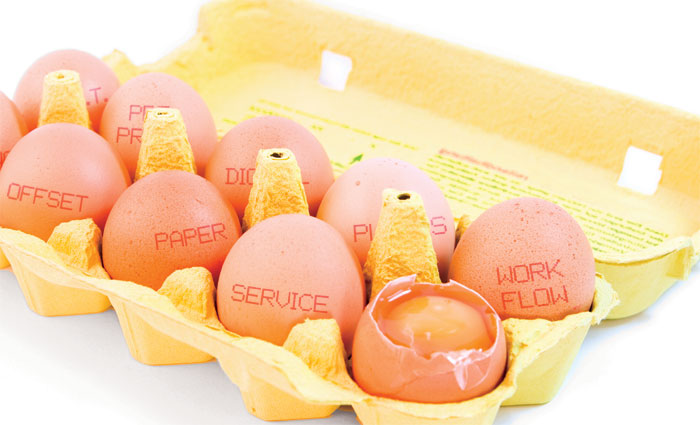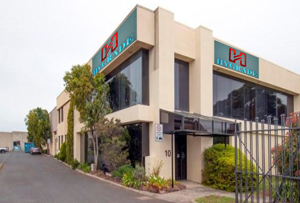
Printing requires intelligence, craftsmanship, business acumen, sales skills – and equipment. Lots and lots of equipment. Every printing company needs several machines for different purposes, which begs the question, should a printer stick with just one vendor or buy from several? In the same way that printers bill themselves as one-stop shops for clients, so too have equipment suppliers increasingly grown their portfolio to comprise partnership with third-party manufacturers as well as comprehensive consumables offerings.
The obvious advantage in having a single supplier of equipment, service and consumables is that if problems arise, one phone call will – or at least should – set the ball rolling to solve it efficiently. With the complexity of modern print workflows, if one supplier provides the lot, that single supplier must be able to track and fix the problem.
Nearly every printer has stories to tell of vendors who absolve themselves of all responsibility because the problem is “obviously” caused by another vendor’s rubbish equipment. Surely everyone has heard an excuse along the lines of, “You’ll have to speak to them, mate; it’s their problem.”
Heaneys Performers in Print, located in Queensland, is largely a one-vendor operation for its presses, according to director Susan Heaney, but there are boundaries in that allegiance. The team’s eyes are not closed to other offers.
“We are generally known as a ‘Heidelberg shop’ because Heidelberg provides our offset print equipment, but we have a close relationship with other suppliers within our business,” she says.
“Even with a single source, we regularly test the market, be it on capital items, or consumables. It pays, and in a technology-driven business, it’s key. Is the status quo forever? As they say in politics, never say never.
“By the same token, I don’t subscribe to the “treat ’em mean, keep ’em keen” school of procurement. I know some who do, and they think they can screw a great deal out of a supplier. I believe more in karma.”
That said, Heaney will of course look for deals from vendors, and uses the competitive marketplace to her own advantage. “I would be naïve to think my price is better through product loyalty. But – and this is a big but – I do drive and expect a better deal on service, whether that is cost, availability or warranty duration. There is a host of ways a supplier can incentivise me to stay exclusive, and it’s not always about the money.”
One size fits all
Suppliers like Heidelberg cover a lot of ground, even offering digital equipment through partnerships, such as the German firm’s deal with Konica Minolta. But in reality, it is seldom that one manufacturer offers all the technology a print company might need. This is why a multiple vendor arrangement is the most likely scenario.
But just because one supplier has signed distribution deals with like-minded technology partners, that doesn’t necessarily mean every printer will be impressed with what the partners’ offer.
As Susan Heaney pointed out: “There is a difference between brand loyalty and blindness. We maintain relationships, but do not go blindly. We educate ourselves on the current state of technology in the particular area, where the equipment supplier is on the technology curve, and what our estimate is on the timing of the product lifecycle. It is always a balancing act, but you do need to be aware of what is being offered in the market, and at what stage of development it is at. It’s equally true to say that pioneers get eaten by Indians – it’s not always best, or smart, to be the first kid on the block with the new toy,” she adds.
Sydney-based SOS Print & Media has plotted its own investment course, and opted for a distinctly different tack to the samey-samey ‘Heidelberg shop’ or ‘HP house’ approach that some printers take.
Director Michael Schulz agrees that there are benefits in sticking with a single supplier but says his company is agnostic when it comes to vendors. There is a wide range of technology from numerous suppliers on the floor in the suburb of Alexandria. On the offset side, it runs a 10-colour Heidelberg Speedmaster SM 102 and a 10-colour Akiyama JPrint. In terms of digital, SOS runs Xeikon and Ricoh equipment, along with the country’s only Kodak Prosper inkjet web press.
Schulz suggests that staying with one supplier may mean missing better technology from a different vendor, “but it does not have to. Nowadays everybody is able to inform themselves without relying on vendor marketing info. Then it is a matter of weighing up technology, service, stability, and so on. We don’t really have one single supply source in equipment and consumables. However, when we did, the service was probably most relevant. Especially with digital engines, a lot of parts need to be stored nearby and have to be replaced and serviced on a regular basis. With several machines from one vendor, the techs are always close and parts usually stored on site,” says Schulz.
Simon Lane, Fuji Xerox Australia’s executive general manager of marketing, says admin and operational structures are more streamlined with one supplier.
“With one supplier, printers benefit by having a simpler process for payment and accounting, as well as a single point of contact when it comes to service and support. As some customers say, they only have ‘one throat to throttle’ – in the case of any issues, they know whom to contact.
“One supplier can also help with operational issues: simplified workflow, simplified training, operators able to operate multiple pieces of equipment.”
He adds that an exclusive arrangement brings home the bacon for both sides of the deal. “Both parties have a vested interest in maintaining a mutually beneficial business arrangement. A supplier can only grow their business if their customers are also growing and thriving.
Based on trust
Mutual support offers both sides of the equation a path for the future, says former Heidelberg Australia New Zealand managing director Andy Vels Jensen. He says that the “obvious advantages” of a single supplier include: doing away with the need to discuss who has ownership; complete trust and commitment between two parties; the fact the product has been tested and approved by one company; and the ability to cover all the equipment with one service support agreement. He adds that it also gives a customer “a certain element of leverage”.
It is not just about the printer; suppliers get a big benefit if one account is of a decent scale. The more a customer invests with them, the more they can give back, says Vels Jensen.
“You also make sure that this chosen supplier of yours survives, thrives and grows successfully with you. These days, it is important you pick your partners and that you support the ones you pick 100%, or as much as humanly possible. Spread yourself too thin and suppliers have a hard time making ends meet and service levels could drop.”
While Heidelberg manufactures a good deal of its equipment for pre-press, press, post-press and software, for fellow German manufacturer Manroland, being a one-stop shop for equipment and consumables supply has been largely a case of shaking on strategic alliances with third parties. For instance, Manroland has a close tie with Océ on digital and offset development. There is also the tie-up with both Screen and Xingraphics in the pre-press and plates arena. In late 2011, Melbourne-based printer Lithocraft invested in a Screen PlateRite CTP system running Xingraphics plates and powered by Screen’s Equios RIP – all of it supplied and serviced by Manroland under its PrintCom brand.
Manroland Australasia managing director Steve Dunwell says: “A business should always be open to listen and learn what’s out there and be willing to change for the good of the business. Take the emotion out of it; it’s business.
“However, in saying that, we see it from the inside of the supply business, and we are convinced that by sticking with one supplier, purchasing machinery and consumables can bring support services to the business that would never be possible if goods were all purchased separately from different suppliers. Customers need to do their homework to ensure the technology is robust and well supported.”
Who scores a better deal: the loyal customer of a single supplier or the tyre kicker who looks around for a deal? According to vendors, the loyal customer will get a better deal than the passer-by.
Dunwell says: “You could go further than that and say they also get far superior service attention, as not only are more technicians of different disciplines on site more regularly, the customers tend to hold a higher daily profile with a supplier and closer relationships with the company’s representatives.
“It also means one supplier takes responsibility and a speedy solution can be sought. A service of immediate invoicing on completion of works or deliveries or e-invoicing could also be an advantage.”
Vels Jensen agrees. “It’s all about value for money, and if you have many reasons to remain in a relationship and very few good reasons why you would want to exit a relationship, you make efforts to improve and invest in the relationship.
“I think it was a [19th century British art critic] John Ruskin who put it this way: ‘It’s unwise to pay too much, but it’s worse to pay too little. When you pay too much, you lose a little money – that’s all. When you pay too little, you sometimes lose everything, because the thing you bought was incapable of doing the thing it was bought to do. The common law of business balance prohibits paying a little and getting a lot – it cannot be done.’”
Wooing new customers
Of course, suppliers would say that, wouldn’t they? They’re not exactly unbiased parties here. Printers seem less convinced about finding a better deal in one shop, and have ways of driving a bargain. If vendors think they can win a new customer, they’ll try harder.
Platypus Graphics managing director Tom Lusch suggests that a contracted supplier will often offer extra services, but one seeking a first deal will go out of their way to make it happen. “You will maybe get better service contracts if you buy several machines at one time, but a new supplier has to prove himself more than an existing one.”
Running equipment from several suppliers used to mean problematic production workflows, but times have changed. Lusch doesn’t consider this a real problem now. “All new machines are JDF-compliant, and need to talk to your MIS, not so much to other equipment.”
This saves the typical printer from being handcuffed to one manufacturer, says Lusch. “A matching fleet and a corporate uniform has appeal, but it is technology that puts you ahead of the pack and makes profitability.”
Workflow wisdom
SOS’s Schulz agrees that workflow technology means any savvy printer can streamline a factory floor regardless of the different badges on the various machines. He recommends this course of action.
“Printers need to build workflows that make them vendor independent. For pure print and file processing purposes, this has really been no problem since the mid-1990s, when PDF became ubiquitous. For information flow, accounting and so on, the MIS is critical and needs to be able to interface with multiple vendors’ equipment using standards like JDF and XML.”
However, the greatest obstacle every printer faces in the wake of ongoing technology updates is complacency. Every printer must stay on top of new developments in both technology and business practice, or risk falling behind their competition.
“Everybody can become too complacent easily,” says Schulz. “It is imperative to constantly look out for new technologies that may have an impact on your business. Every supplier has their own preferences and times when they are behind progress and cannot compete or offer new technologies that may be beneficial to your business.”
Heaney admonishes printers who become too set in their ways by sticking with one supplier for no other reason than ‘that’s what we have always done’.
“I call that lazy, and the dinosaurs got lazy,” she adds.
Pros of a single supplier
1. A single source of supply provides regularity and reliability. It also makes invoicing, tracking and finance easier.
2. Service and maintenance is simplified, with unavoidable responsibility. Any problem means one phone call.
3. A close relationship is easier to develop, providing better communication and response.
4. Production capabilities are optimised through same brand technology working together more effectively.
5. Sole providers are likely to offer better deals to loyal customers.
6. Vendor finance deals are easier to arrange.
Cons of a sole supplier
1. Printers may miss out on a better technology solution from another vendor for their needs.
2. Technology handicaps may limit the ability of the business to grow or pursue other markets.
3. A lack of vendor competition may prevent better deals.
4. The chance of moving to another vendor keeps current vendors on their toes.
5. A risk of being caught out if the vendor falls over or stalls.
6. Vendors will try harder to win business through innovative offers and deals.
Comment below to have your say on this story.
If you have a news story or tip-off, get in touch at editorial@sprinter.com.au.
Sign up to the Sprinter newsletter


